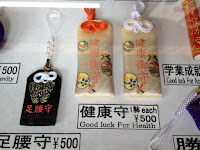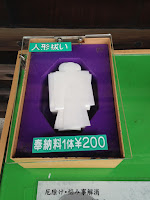Kiyomizu-Dera Temple | 清水寺
[清] - Kiyo =Pure [水]- Mizu = Water [寺]- Dera = TemplePure * Water * Temple
The temple is an example of how Buddhism Japan coexists with the local Shinto roots. While the main deity of the temple is Kannon, a Buddhist goddess, the temple still contains various shrines, Torii gates and prayer traditions that are dedicated to the local Kami of the mountain.
They sell out traditional Omamori, which are talismans that are wrapped in a heavily decorated silk bag.Usually it has the name of the temple embroidered on the back and the name of the blessing you want on the front. The Omamori are traditional protection talismans that are a combination of Shinto and Buddhist beliefs, as the talismans originate from traditional Chinese Buddhist prayer tags and the way they are packaged and blessed are Shinto.
Omamori (Left) Human Talisman (right)
Upon my first trip to Kyoto in 2014, I visited the during the Summer Fuyu (Rainy Season) and Mt. Otowa was covered in the Hydrangeas, flower of the season. Despite the large amount of tourists, I was still able to find places around the temple complex that was separated away from the crowd. These quiet spaces really allowed me to appreciate the natural beauty of the nature and the Temple itself. The dark wood glowed warmly from the nearby candles and helped to illuminate solemn temple spaces that the grey clouds created. It was a very somber yet calming atmosphere. It really emphasizes that the ancient Japanese were very aware of embodying symbolism and the spiritual aura within their designs and intentions.







Comments
Post a Comment